by Active Wild Admin
6/29/2023
Irrawaddy Dolphin
Family: Delphinidae
Length: 2.3 to 2.6 meters (7.5 to 8.5 feet)
Weight: 90 to 200 kg (198 to 440 lbs)
Where found: Shallow, near-shore tropical & subtropical marine waters of Southeast Asia, & in 3 large rivers: the Ayeyarwady in Myanmar, the Mahakam in Indonesian Borneo, & the Mekong.
Conservation status: Vulnerable
The Irrawaddy Dolphin has a rounded body with a high & rounded forehead, & lacks a beak. Its color is uniformly slate blue to slate gray. It is found in coastal areas, & will also enter freshwater habitats. Although sometimes called the Irrawaddy river dolphin, it belongs to the oceanic dolphin family, Delphinidae.
Killer Whale (Orca)
Family: Delphinidae
Length: Up to 9.6 meters in males, up to 7 meters in females (31.5 feet in males, 23 feet in females)
Weight: Up to 6 tons in males, up to 4 tons in females (13,227 lbs in males, 8,818 lbs in females)
Where found: Distributed across global oceans, from Arctic & Antarctic regions to tropical seas
Conservation status: Data Deficient
Known for its distinctive black & white coloring, the killer whale, or orca, is the largest species of dolphin. It has a heavy & robust body & a large dorsal fin.
The killer whale is an apex predator with no predators of its own. It hunts fish & marine mammals. The species is highly social & often travels in family groups which can contain up to 4 generations.
Long-Finned Pilot Whale
Scientific Name: Globicephala melas
Family: Delphinidae
Length: 5.5 to 7.5 meters (18 to 25 feet)
Weight: 1,300 to 2,300 kg (2,866 to 5,070 lbs)
Where found: Both northern & southern hemispheres, in temperate & sub-polar areas
Conservation status: Least Concern
The long-finned pilot whale is a large dolphin species distinguished by its long, sickle-shaped pectoral fins & bulbous forehead. Its body is dark, usually black or very dark gray, with lighter patches on the throat & belly.
This species inhabits both open & coastal waters of the cooler regions of the Southern Hemisphere & the North Atlantic Ocean.
The long-finned pilot whale has been subject to mass strandings on beaches, the cause of which remains largely unknown. It also faces threats from hunting in some regions & incidental capture in fishing gear.
Melon-Headed Whale
Family: Delphinidae
Length: 2.5 to 2.75 meters (8.2 to 9.0 feet)
Weight: 200 to 300 kg (440 to 660 lbs)
Where found: Tropical oceans worldwide
Conservation status: Least Concern
Despite its name, the melon-headed whale is actually a dolphin. It has a somewhat conical, beak-less head (from which it gets its name) with a body that tapers to a narrow tail. It is typically dark gray with lighter undersides.
The melon-headed whale is highly social, forming pods that often contain several hundreds of individuals. The largest melon-headed whale pods contain up to 2,000 individuals.
Northern Right Whale Dolphin
Family: Delphinidae
Length: 2.1 to 3 meters (6.9 to 9.8 feet)
Weight: 100 to 150 kg (220 to 330 lbs)
Where found: North Pacific Ocean
Conservation status: Least Concern
The northern right whale dolphin is sleek & slender with a distinctive black & white pattern. It lacks a dorsal fin, which gives it a unique, smooth profile.
The species is often found in large groups. It is a fast swimmer that feeds on small fish & squid.
Pacific White-Sided Dolphin
Family: Delphinidae
Length: 1.9 to 2.5 meters (6.2 to 8.2 feet)
Weight: 150 to 200 kg (330 to 440 lbs)
Where found: North Pacific Ocean, from Japan to California
Conservation status: Least Concern
The Pacific white-sided dolphin has a dark gray body with a white underside & distinctive gray stripes on the sides. Its snout is short & its dorsal fin tall & hooked.
It lives in groups containing 10 to 100 individuals, & is known to take care of sick or injured members of its group.
Pantropical Spotted Dolphin
Family: Delphinidae
Length: 1.8 to 2.7 meters (5.9 to 8.9 feet)
Weight: 80 to 130 kg (176 to 286 lbs)
Where found: Warm waters of the Atlantic, Pacific, & Indian Oceans
Conservation status: Least Concern
Pantropical spotted dolphins have a slender body with a distinct dark dorsal cape, spots covering their light gray or white sides, & a dark eye ring. They are highly social & often seen leaping & riding the bow waves of boats.
The pantropical spotted dolphin is one of the world’s most abundant dolphin species.
Peale's Dolphin
Family: Delphinidae
Length: 2.1 to 2.5 meters (6.9 to 8.2 feet)
Weight: 115 to 130 kg (253 to 286 lbs)
Where found: Waters around the Falkland Islands & the southern tip of South America
Conservation status: Least Concern
Peale's dolphin has a robust body, a short beak, & is dark gray to black in color, with white patches around its flippers & on its tail. It is also known as the black-chinned dolphin.
Peale's dolphin lives in small pods & is occasionally seen with other dolphins, including Commerson's dolphin.
Pygmy Killer Whale
Family: Delphinidae
Length: 2.1 to 2.6 meters (6.9 to 8.5 feet)
Weight: 110 to 170 kg (243 to 375 lbs)
Where found: Tropical & subtropical oceans worldwide
Conservation status: Least Concern
The pygmy killer whale is a small, dark dolphin with a rounded head & no beak. It has a falcate (hooked or curved like a sickle) dorsal fin & long, pointed flippers. Despite its name, it is not closely related to the killer whale.
Risso's Dolphin
Family: Delphinidae
Length: 2.6 to 4 meters (8.5 to 13.1 feet)
Weight: 300 to 500 kg (661 to 1,102 lbs)
Where found: Temperate & tropical oceans worldwide
Conservation status: Least Concern
Risso's Dolphins have a robust body with a unique creased forehead, a tall dorsal fin, & a dark gray body covered in extensive white scarring. They feed almost exclusively on squid & are known for their deep diving abilities.
Rough-Toothed Dolphin
Family: Delphinidae
Length: 2.1 to 2.9 meters (6.9 to 9.5 feet)
Weight: 100 to 150 kg (220 to 330 lbs)
Where found: Tropical & subtropical oceans worldwide
Conservation status: Least Concern
Rough-toothed Dolphins are named for the distinctive ridges on their teeth. They have a slim body, a long beak, a tall dorsal fin, & a dark gray color with lighter patches. They are typically found in deep offshore waters & feed on fish & squid.
Short-Finned Pilot Whale
Family: Delphinidae
Length: 3.6 to 6.7 meters (12 to 22 feet)
Weight: 1,000 to 3,000 kg (2,204 to 6,613 lbs)
Where found: Tropical & temperate oceans worldwide
Conservation status: Least Concern
Similar to the long-finned pilot whale but with shorter fins, shorter beak, & fewer teeth, the short-finned pilot whale has a round forehead, bulbous melon, & a dark gray to black body.
Like its long-finned cousin, the short-finned pilot whale is prone to mass stranding events.
Southern Right Whale Dolphin
Scientific Name: Lissodelphis peronii
Family: Delphinidae
Length: 2.2 to 3 meters (7.2 to 9.8 feet)
Weight: 100 to 150 kg (220 to 330 lbs)
Where found: Cold waters of the Southern Hemisphere
Conservation status: Least Concern
Similar in appearance to its northern counterpart, the southern right whale dolphin has a streamlined body, a small fluke, & lacks a dorsal fin. It is generally black with a white belly & throat, & is known to be a very active & fast swimmer.
Spinner Dolphin
Family: Delphinidae
Length: 1.2 to 2.3 meters (3.9 to 7.5 feet)
Weight: 55 to 75 kg (121 to 165 lbs)
Where found: Tropical oceans worldwide
Conservation status: Least Concern
Spinner Dolphins are known for their acrobatic displays, often leaping & spinning out of the water. This behavior may be a form of communication, or a means to remove parasites (or both). They have slim bodies, a long thin beak, & most have a distinctive tri-color pattern with a dark gray dorsal area, a light gray middle, & white or light gray undersides.
Striped Dolphin
Scientific Name: Stenella coeruleoalba
Family: Delphinidae
Length: 1.8 to 2.6 meters (5.9 to 8.5 feet)
Weight: 100 to 140 kg (220 to 308 lbs)
Where found: Tropical & warm temperate waters worldwide
Conservation status: Least Concern
Striped dolphins have a slender, streamlined body with a prominent beak & a dark bluish-gray color on their back, light gray on their sides, & a characteristic blue & white striped pattern along their flanks. The species lives in large groups that may contain thousands of individuals.
Tucuxi
Family: Delphinidae
Length: 1.5 to 1.8 meters (4.9 to 5.9 feet)
Weight: 40 to 60 kg (88 to 132 lbs)
Where found: Coastal waters, estuaries, & rivers of the Amazon & Orinoco basins in South America
Conservation status: Endangered
The tucuxi is a small dolphin with a stocky body, a rounded head, & a prominent beak. It is dark gray to black in color with lighter undersides.
Despite being a member of the oceanic dolphin family, the tucuxi is only found in freshwater habitats. It inhabits the Amazon River Basin in South America.
The tucuxi is occasionally observed with the Amazon river dolphin, but the 2 species are unrelated.
White-Beaked Dolphin
Family: Delphinidae
Length: 3.3 meters (10.8 feet)
Weight: 200 to 350 kg (440 to 770 lbs)
Where found: Cold-temperate waters of the North Atlantic Ocean, including the coasts of Iceland, Greenland, & parts of Europe
Conservation status: Least Concern
As its name suggests, the white-beaked dolphin typically has a white beak, although this is less noticeable in some individuals. It is found in cold northerly waters.
Amazon River Dolphin
Family: Iniidae
Length: 1.5 to 2.5 meters (4.9 to 8.2 feet)
Weight: 85 to 160 kg (187 to 352 lbs)
Where found: Amazon River & its tributaries in South America
Conservation status: Endangered
The Amazon River dolphin, also known as the pink river dolphin or boto, has a unique appearance, with some individuals having an almost entirely pink-gray color.
The species’ neck vertebrae are unfused, allowing it to turn its head 90 degrees. This adaptation allows the dolphin to turn in tight circles, helping it to maneuver through flooded forests.
Baiji
Scientific Name: Lipotes vexillifer
Family: Lipotidae
Length: Up to 2.5 meters (8.2 feet)
Weight: 110 to 170 kg (243 to 375 lbs)
Where found: Yangtze River in China
Conservation status: Critically Endangered (Possibly Extinct)
The baiji, also known as the Yangtze River Dolphin, was a freshwater dolphin found in China’s Yangtze river system.
No confirmed sightings of the baiji have been made since 2002, & it is likely that the species is now extinct.
The baiji had a distinctive long, narrow beak & was light gray to bluish in color. Its vision was poor, & it relied on echolocation to navigate the murky waters of the Yangtze.
Franciscana
Family: Pontoporiidae
Length: 1.4 to 1.7 meters (4.6 to 5.6 feet)
Weight: Up to 50 to 55 kg (110 to 121 lbs)
Where found: Coastal waters of the southwestern Atlantic Ocean, particularly around Argentina, Brazil, & Uruguay
Conservation status: Vulnerable
The franciscana, also known as La Plata dolphin, has a slender body, a rounded head, & a long beak. It has a grayish back, fading to a lighter shade on the sides & belly. Although a river dolphin, it is typically found close to the shore in coastal waters, or in estuaries.
South Asian River Dolphin(s)
Family: Platanistidae
Length: 2 to 2.5 meters (6.6 to 8.2 feet)
Weight: 70 to 90 kg (154 to 198 lbs)
Where found: Rivers of the Indian subcontinent, including the Ganges, Brahmaputra, & Indus River systems
Conservation status: Endangered
The South Asian river dolphin has a long, slender body & a long beak with sharp teeth. It is grayish-brown in color with a lighter underside.
Having evolved in murky river water, the South Asian river dolphin has no use for acute eyesight. As a result, its eyes are undeveloped & it is virtually blind. It navigates & hunts instead using its highly-developed sonar system.
Research carried out in 2021 suggests that the Ganges river dolphin & the Indus river dolphin, previously believed to be subspecies of the South Asian river dolphin, are separate species.
Many authorities now recognize this change, with the Ganges river dolphin taking the scientific name Platanista gangetica, & the Indus river dolphin having the scientific name Platanista minor. Both of the newly-recognized species are endangered.



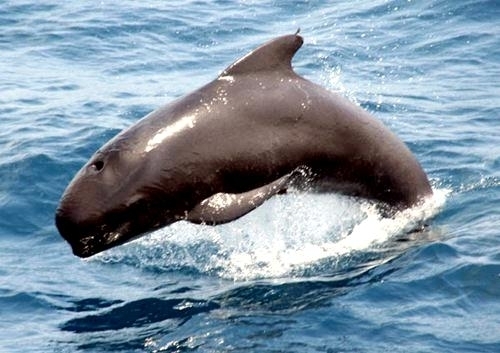


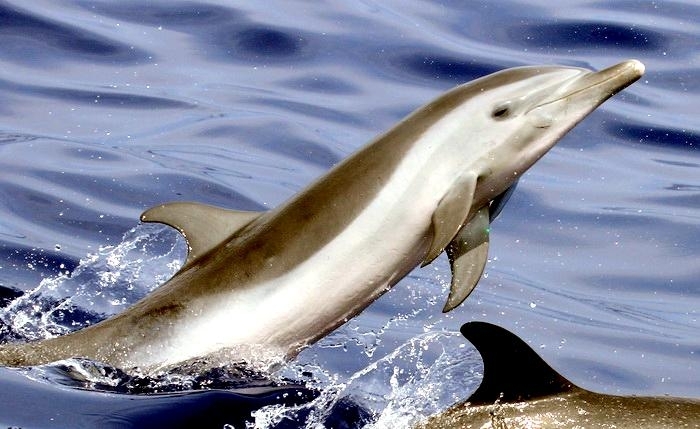
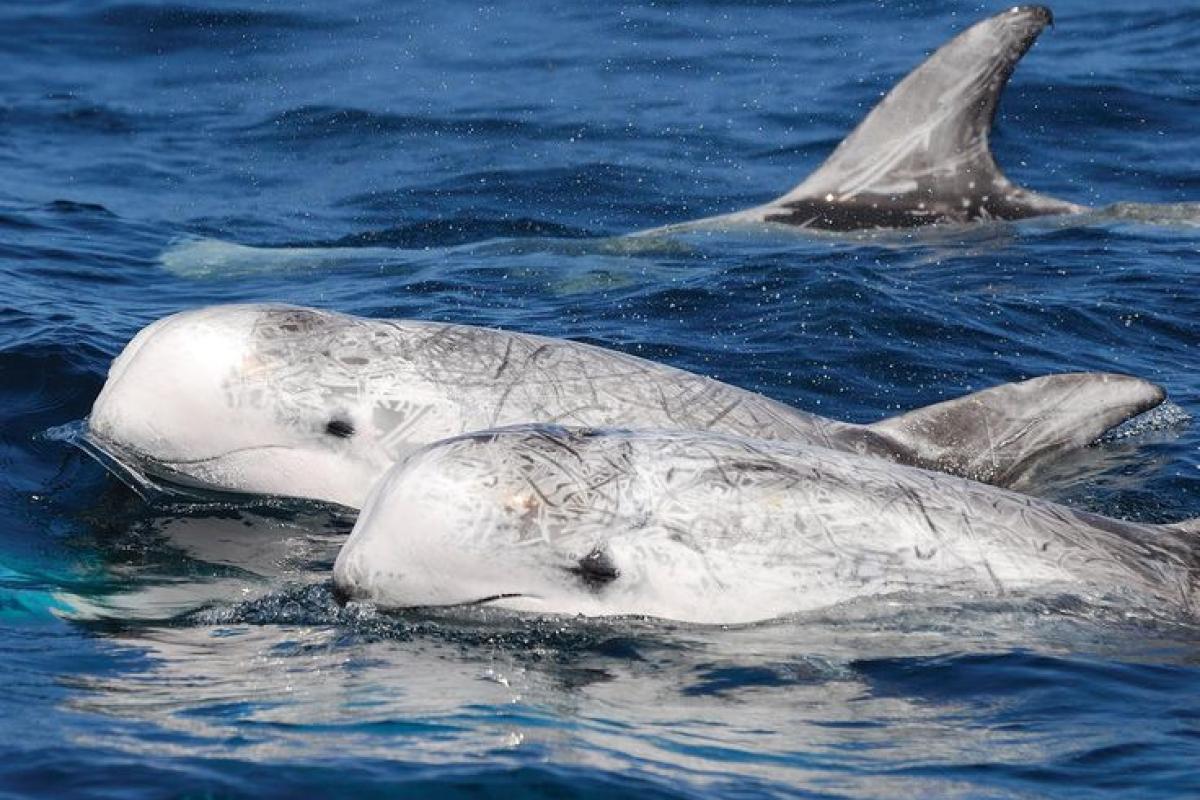
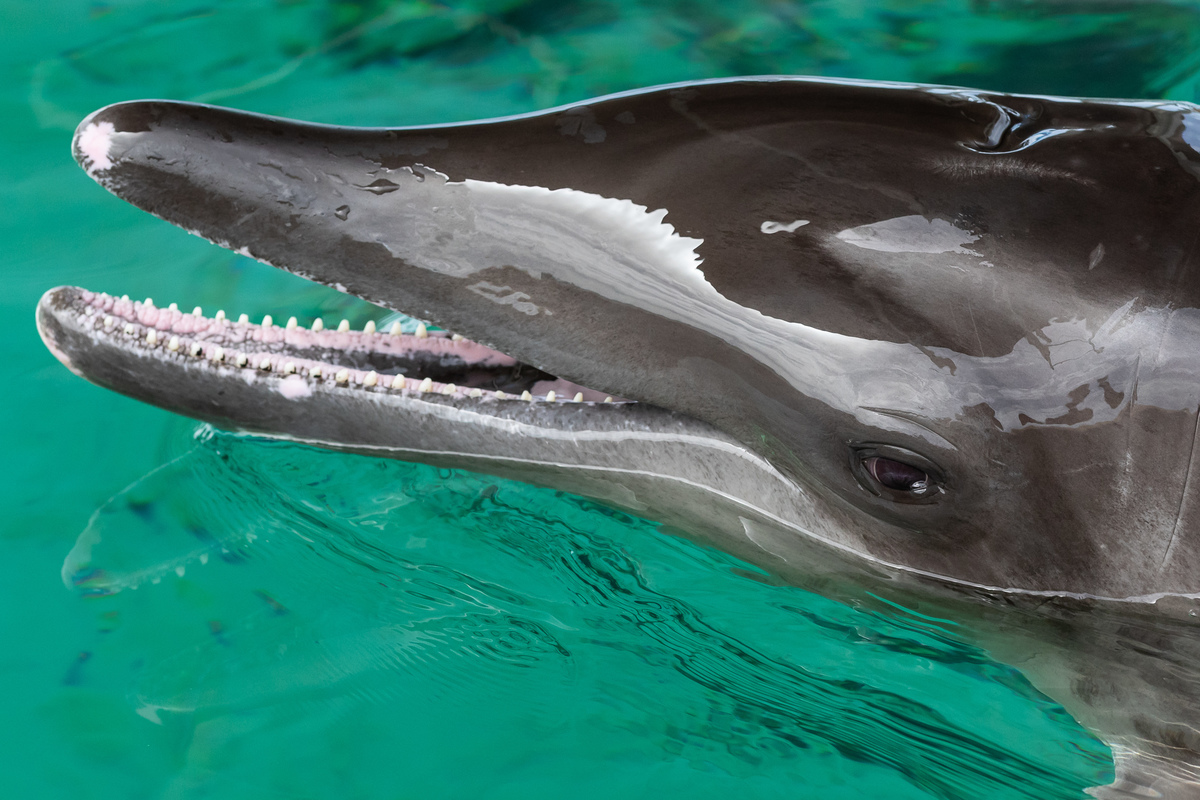






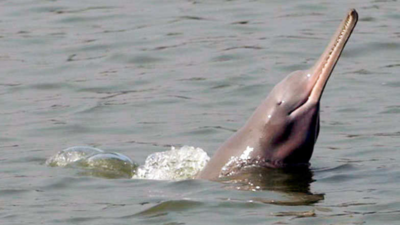





No comments:
Post a Comment